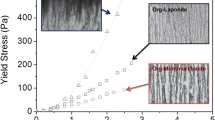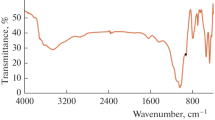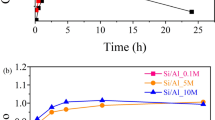Abstract
The hydrolysis and decomposition of M-hectorite (M being Na, Li, Mg, or Ca) in dilute solutions of M-chlorides were studied by recording the changes in electrical conductivity (EC) of the clay suspensions with time, and by chemical analyses of the interclay solutions and resulting solid phases. The rate of hydrolysis of the hectorites in suspension, as evaluated by the change of EC with time, was found to decrease with increase in salt concentration (to zero for Na-hectorite in NaCl concentration of 47 meq/liter), and to decrease with increase in the valency of the adsorbed cation (the rate of hydrolysis of Ca-hectorite was one sixth of that of Na-hectorite). The rate of Na-hectorite hydrolysis was determined by the concentration of protons at the clay surface as calculated from the diffuse double layer theory.
Conversely, in suspensions of Al-hectorite saturated with Na, the hydrolysis rates were not dependent on the electrolyte concentrations. This result can be explained by assuming that the hydroxy-Al polymers at the clay surface determine the proton concentration at the clay surface. Hectorites saturated with structural cations (such as Mg and Li) are chemically more stable than those saturated with Na and Ca. The presence of Li and Mg at the clay surface slowed down the diffusion release of these octahedral ions to the clay surface, compared with Na and Ca hectorite, respectively.
Резюме
Исследовались гидролиз и реакция разложения М-гекторита (где M то Na, Li, Mg, или Ca) в разбавленных растворах М-хлоридов путем регистрации изменений по времени электрической проводимости (ЭП) глиновых суспензии и путем химического анализа межглиновых растворов и получающихся твердых тел. Скорость гидролиза гекторита в суспензии, получаемая путем изменений ЭП по времени, уменьшалась с увеличением концентрации соли (полностью исчезая для Nа-гекторита при концентрации NaCl равной 47 мэкв/литр), а также с увеличением валентности адсорбированного катиона (скорость гидролиза Са-гекторита составляла одну шестую величины для Nа-гекторита). Скорость кидролиза Na-гекторита определялась по концентрации протонов на поверхности глины как это вычисляется по теории диффузионного двойного слоя.
В противоположность, в суспензиях Al-гекторита, насыщенного Na, скорости гидролиза были независимы от концентрации электролита. Этот результат можно объяснить принимая, что гидрокси-алюминиевые полимеры на поверхности глины определяют концентрацию протонов на поверхности глины. Гекториты, насыщенные структурными катионами (такими как Mg и Li), являются химически более стабильными, чем гекториты, насыщенные Na и Ca. Присутствие Li и Мg на поверхности глины замедляло диффузионное освобождение этих октаэдрических ионов на поверхности глины по сравнению с Na- и Ca-гекторитами, соответственно. [E.C.]
Resümee
Es wurde die Hydrolyse und Zersetzung von M-Hektorit (M = Na, Li, Mg, oder Ca) in verdünnten Lösungen von M-Chloriden untersucht. Dazu wurde die Änderung der elektrischen Leitfähigkeit (EC) der Tonsuspensionen im Laufe der Zeit verfolgt, und die Lösungen in den Zwischenschichten sowie die neugebildeten Festphasen chemisch analysiert. Wie aus der Veränderung der EC im Laufe der Zeit hervorgeht, nimmt die Hydrolysegeschwindigkeit der Hektorite in der Suspension mit zunehmender Salzkonzentration ab (bis auf 0 für Na-Hektorit bei einer NaCl-Konzentration von 47 mÄq/Liter), sowie bei zunehmender Wertigkeit der adsorbierten Kationen (e.g., die Hydrolysegeschwindigkeit von Ca-Hektorit war nur 1/6 von der des Na-Hektorits). Die Hydrolysegeschwindigkeit von Na-Hektorit wurde mittels der Protonenkonzentration auf der Tonoberfläche bestimmt, die mit der Theorie der diffusen Doppelschicht berechnet wurde.
Im Gegensatz dazu war die Hydrolysegeschwindigkeit von Al-Hektorit in mit Na gesättigten Suspensionen nicht von den Elektrolytkonzentrationen abhängig. Dieses Ergebnis kann durch die Annahme erklärt werden, daß die Aluminium-Hydroxy-Polymere an den Tonoberflächen die Protonenkonzentration an der Tonoberfläche bestimmen. Hektorite, die mit Struktur-Kationen gesättigt sind (wie Mg oder Li) sind chemisch stabiler als Hektorite, die mit Na oder Ca gesättigt sind. Das Vorhandensein von Li und Mg an der Tonoberfläche verzögert die Diffusion der Oktaederkationen an die Tonoberfläche im Vergleich zu Nabzw. Ca-Hektorit. [U.W.]
Résumé
L’hydrolyse et la décomposition d’hectorite-M (M étant Na, Li, Mg, ou Ca) dans des solutions diluées de chlorides-M ont été étudiées en enregistrant les changements de la conductivité électrique (EC) des solutions argileuses avec le temps, et par des analyses chimiques des solutions interargile et des phases solides résultantes. On a trouvé que le taux d’hydrolyse des hectorites en suspension, évalué d’après le changement d’EC avec le temps, décroissait avec une augmentation de la concentration en sel (zéro pour l’hectorite-Na dans une concentration NaCl de 47 meq/litre), et décroissait avec une augmentation de la valence du cation adsorbé (le taux d’hydrolyse de l’hectotite-Ca était un sixième de celui de l’hectorite-Na). Le taux d’hydrolyse de l’hectorite-Na a été déterminé par la concentration de protons à la surface de l’argile, calculé à partir de la théorie de la couche double diffuse.
Réciproquement, dans des suspensions d’hectorite-Al saturées de Na, les taux d’hydrolyse n’étaient pas dépendants des concentrations sur l’électrolyte. Ce résultat peut être expliqué en assumant que les polymères hydroxy aluminium à la surface de l’argile déterminent la concentration de protons à la surface de l’argile. Les hectorites saturées de cations structuraux (tels que Mg et Li) sont chimiquement plus stables que celles saturées de Na et Ca. La présence de Li et Mg à la surface de l’argile a ralenti le déchargement par diffusion de ces ions octaèdraux à la surface de l’argile en comparaison avec les hectorites-Na et -Ca, respectivement. [D.J.]
Similar content being viewed by others
References
American Petroleum Institute (1951) Preliminary reports, American Petroleum Institute Research Project 49, Reference clay minerals: Columbia University, New York, p. 55.
Barnishel, R. I. (1977) Chlorites and hydroxy interlayerd ver-miculites and smectites: in Minerals in Soil Environments, J. B. Dixon and S. B. Weed, eds. Amer. Soc. Agronomy, Madison, Wisconsin, 331–356.
Bar-On, P. and Shainberg, I. (1970) Hydrolysis and decomposition of Na-montmorillonite in distilled water: Soil Sci. 109, 242–246.
Barshad, I. (1960) The effect of the total chemical composition and crystal structure of soil minerals on the nature of exchangeable cations in acidified clays and in naturally occurring acid soils: Trans. 7th Int. Cong. Soil Sci., Madison, Wisconsin, vol.2, 435–444.
Barshad, I. and Foscolos, A. (1970) Factors affecting the rate of the interchange reaction of adsorbed H+ on the 2:1 clay minerals: Soil Sci. 110, 52–60.
Black, C. A. (1965) Methods of Soil Analysis: Part 2. Amer. Soc. Agronomy, Madison, Wisconsin, 1572 pp.
Brown, A. S. and Miller, R. J. (1971) Bentonite instability and its influence on activation energy measurements: Soil Sci. Soc. Amer. Proc. 35, 705–709.
Eeckman, J. P. and Laudelout, H. (1961) Chemical stability of hydrogen montmorillonite suspension: Kolloid Z. 178, 99–107.
Feigenbaum, S. and Shainberg, I. (1975) Dissolution of illite, a possible mechanism of potassium release: Soil Sci. Soc. Amer. Proc. 39, 985–990.
Frenkel, H. and Suarez, D. L. (1977) Hydrolysis and decomposition of calcium montmorillonite: Soil Sci. Soc. Amer. J. 41, 887–891.
Frink, C. R. (1965) Characterization of aluminum interlayers in soil clays: Soil Sci. Soc. Amer. Proc. 29, 379–382.
Frink, C. R. and Peech, M. (1963) Hydrolysis and exchange reactions of the aluminum ion in hectorite and in montmorillonite suspensions. Soil Sci. Soc. Amer. Proc. 27, 527–530.
Jackson, M. L. (1963) Aluminum bonding in soils: a unifying principle in soil sicence: Soil Sci. Soc. Amer. Proc. 27, 1–10.
Kamil, J. and Shainberg, I. (1968) Hydrolysis of sodium montmorillonite in sodium chloride solutions. Soil Sci. 106, 193–199.
Kelley, W. F. (1951) Alkali Soils: Reinhold, New York, 176 pp.
Llorca, R. and Cruz-Romero, G. (1977) Hydrolysis reactions in sodium montmorillonite suspension: J. Soil Sci. 28, 473–484.
Osthaus, B. B. (1956) Kinetic studies on montmorillonite and montronite by acid dissolution technique: in Clays and Clay Minerals, Proc. 4th Natl. Conf., University Park, Pennsylvania, 1955, Ada Swineford, ed., Natl. Acad. Sci. Natl. Res. Counc. Publ. 456, Washington, D.C., 301–321.
Schwertmann, U. and Jackson, M. L. (1964) Influence of hydroxy aluminum ions on pH titration curves of hydronium-aluminum clays. Soil Sci. Soc. Amer. Proc. 28, 179–183.
Shainberg, I. (1973) Rate and mechanism of Na-montmoril-lonite hydrolysis in suspensions. Soil Sci. Soc. Amer. Proc. 37, 689–694.
Shainberg, I., Low, P. F., and Kafkafi, U. (1974) Electrochemistry of sodium-montmorillonite suspensions: I. Chemical stability of montmorillonite. Soil Sci. Soc. Amer. Proc. 38, 751–756.
Van Olphen, H. (1963) An Introduction to Clay Colloid Chemistry: Wiley-Interscience, New York, 301 pp.
Author information
Authors and Affiliations
Additional information
Contribution from the Agricultural Research Organization, The Volcani Center, Bet Dagan, Israel. No. E-129, 1980 series.
Rights and permissions
About this article
Cite this article
Kreit, J.F., Shainberg, I. & Herbillon, A.J. Hydrolysis and Decomposition of Hectorite in Dilute Salt Solutions. Clays Clay Miner. 30, 223–231 (1982). https://doi.org/10.1346/CCMN.1982.0300309
Received:
Accepted:
Published:
Issue Date:
DOI: https://doi.org/10.1346/CCMN.1982.0300309




